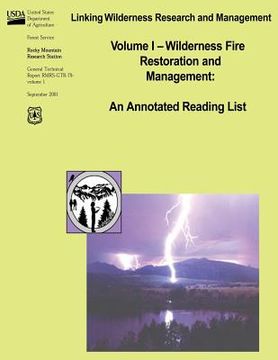Linking Wilderness Research and Mangement: Volume 1 - Wilderness Fire Restoration and Management: An Annotated Reading List
Synopsis "Linking Wilderness Research and Mangement: Volume 1 - Wilderness Fire Restoration and Management: An Annotated Reading List"
Humans have long maintained a complex and dynamic relationship with wildland fire. While native North Americans utilized fire for hundreds of years to promote growth of certain plants, facilitate hunting, and clear travel corridors (Williams 1994), during most of the 20th century fire on U.S. public lands was viewed as dangerous and destructive. For decades, Federal agencies have worked to suppress and minimize wildland fire on public lands, including wilderness and other similarly protected areas (Parsons and Landres 1998). To protect scenery and natural features, for example, early National Park managers worked to save these areas from destruction by fire (Parsons and Botti 1996). Yet ecological research gradually revealed that fire plays a more complex role in ecosystems than we previously believed (Christensen 1988). Although it is true that fire changes landscapes, many of these changes help to maintain mosaics of vegetation, recycle nutrients, and conserve biological diversity (Kilgore 1986). Additionally, anthropological research has shown that humans have not always had an adversarial relationship with fire, and that in fact, fire played an important role in the hunting and gathering systems of many Native American tribes (Lewis 1985). In light of this understanding, fire management on U.S. Federal lands has changed. Rather than attempt to suppress all fires, managers now work to minimize the risks associated with fire while allowing fire to play a more natural role in maintaining ecological processes and communities (NPS and others 1998). Permitting a natural role for fire is particularly appropriate for wilderness and protected areas with the mandate to maintain natural conditions; however, restoring fire to ecosystems after decades of fire suppression poses many challenges (Parsons 2000). In many areas, the structure and composition of plant communities has changed in response to fire suppression. In the absence of fires, woody fuels tend to accumulate in forests, which in turn can increase their susceptibility to intense fires (Arno and others 2000). Additionally, due to population growth and development, many wilderness areas and National Parks now border homes or communities, increasing the risks associated with escaped fires. Restoring fire to wilderness and protected areas requires management that integrates ecological and social knowledge, taking into account the effects of various management options on plant, animal, and human communities. The literature collected here represents a small subset of this vast literature, selected for its relevance to the issue of wilderness fire restoration and management. As a broad overview of the literature on wilderness fire, this reading list does not offer sufficient information on which to base fire management plans. Specific plans for restoring and managing fire in wilderness will require site-specific knowledge, because ecosystems are varied and complex. An understanding of local plant communities, their effects on fire behavior, and their responses to fire will be of central importance, as will information on animal distributions, behavior and habitat requirements, patterns of natural and human disturbance, jurisdictional boundaries, social and recreational values, and risks to life and property. Nonetheless, the structure of this reading list, and the papers we have cited and annotated, should provide readers with a conceptual framework for applying wilderness fire research to management. Furthermore, the reading list can help readers to identify the types of local and regional knowledge needed to manage fire in wilderness in accordance with the purposes set forth in the Wilderness Act and similar legislation designed to protect the values of naturalness and wildness on public lands.

